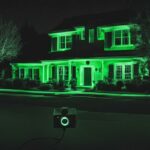Have you ever wondered if it’s possible to see infrared LED lights? Infrared LED lights are invisible to the human eye, yet they are widely used in a variety of applications such as night vision, security cameras, and even in the healthcare field. But can you, in fact, see them? In this article, we’ll explore the science behind infrared LED lights and how it may be possible to see them. We’ll also examine some of the potential applications of infrared LED lights. So if you’ve ever been curious about this unique form of light, then read on to find out more!
Yes, you can see infrared LED lights. Infrared light is invisible to the human eye, but by using a camera with an infrared filter, you can capture the image of the light. You can also use a night-vision device to see infrared LED lights, as it amplifies the light.

Contents
Can Humans See Infrared LED Lights?
Infrared LED lights, or IR LEDs, are a type of light emitting diode (LED) that emits infrared light in the range of 700 nanometers (nm) to 1 millimeter (mm). The human eye cannot detect infrared light, so it appears dark to the naked eye. However, many devices such as cameras, night vision goggles, and remote controls are able to see and use infrared light. In this article, we will discuss whether or not humans can see infrared LED lights.
Infrared Light and the Human Eye
The human eye is only capable of seeing light in the visible spectrum, which ranges from about 380 nm to 750 nm. Infrared light is outside of this range and therefore cannot be seen by the human eye. In order for us to detect infrared light, we would need a device such as a camera or night vision goggles. These devices use specially-designed lenses and sensors to detect and capture infrared light.
How Infrared LED Lights Work
Infrared LED lights use a semiconductor material such as gallium arsenide to convert electrical energy into infrared light. The semiconductor material is sandwiched between two electrodes, and when a voltage is applied across the electrodes, the semiconductor material emits infrared light. The intensity of the infrared light depends on the voltage applied to the electrodes.
Uses of Infrared LED Lights
Infrared LED lights are used in a variety of applications, such as night vision devices, remote controls, and security systems. The use of infrared LED lights allows for these devices to operate without emitting visible light, which can be a security concern in certain situations. Infrared LED lights are also used in medical imaging and surgery, as the infrared light can penetrate the human body more deeply than visible light.
How to Detect Infrared LED Lights
While the human eye cannot detect infrared LED lights, there are a few ways to detect them. The easiest way is to use a camera or night vision device that is designed to detect infrared light. These devices are able to capture and display the infrared light, allowing us to see what the human eye cannot.
Conclusion
Infrared LED lights are a type of light emitting diode (LED) that emits light in the infrared spectrum, which is invisible to the human eye. However, many devices such as cameras, night vision goggles, and remote controls are able to detect and use infrared light. Infrared LED lights are used for a variety of applications, such as night vision, remote controls, and medical imaging. While the human eye cannot detect infrared LED lights, there are devices available to detect and display the infrared light.
Top 6 Frequently Asked Questions
What is an infrared LED light?
An infrared LED light is an LED (Light Emitting Diode) that emits light in the infrared spectrum. This light is not visible to the human eye, but it can be detected by some electronic devices. Infrared LED lights are commonly used in remote controls, security systems, and other electronic devices that require a signal to be sent or received.
What are the advantages of using infrared LED lights?
The main advantage of using infrared LED lights is that they can be used in areas where visible light is not an option. Infrared LED lights have a longer range than visible light, making them ideal for applications where the user needs to be able to detect the signal from a far distance. Additionally, infrared LED lights are energy efficient, require minimal maintenance, and are relatively inexpensive.
Can you see infrared LED lights?
No, infrared LED lights are not visible to the human eye. Infrared LED lights emit light in the infrared spectrum, which is outside of the visible light spectrum.
How does infrared LED light work?
Infrared LED lights work by emitting light in the infrared spectrum. This light is not visible to the human eye, but it can be detected by some electronic devices. The LED light emits a signal that can be picked up by the electronic device, allowing the device to send or receive information.
What are some applications of infrared LED lights?
Infrared LED lights are commonly used in a variety of applications, including remote controls, security systems, and other electronic devices that require a signal to be sent or received. Additionally, infrared LED lights are also used in medical science, robotics, optical communication, and for measuring the temperature of objects.
Are infrared LED lights dangerous?
No, infrared LED lights are not dangerous. Infrared LED lights emit light in the infrared spectrum, which is outside of the visible light spectrum. This light has no effect on the human body and is not considered a hazard. Similarly, infrared LED lights do not emit harmful radiation, so there is no need for safety precautions when using them.
How to see infrared light
In conclusion, it is clear that infrared LED lights can be seen, but only with special equipment that detects the wavelengths of light they emit. These lights are often used in night vision devices, security cameras, and other applications that require extra light in the dark. Not only do they provide effective illumination, but they also provide an added layer of security and protection. With their versatile uses and easy availability, infrared LED lights are an invaluable asset for many fields and applications.








